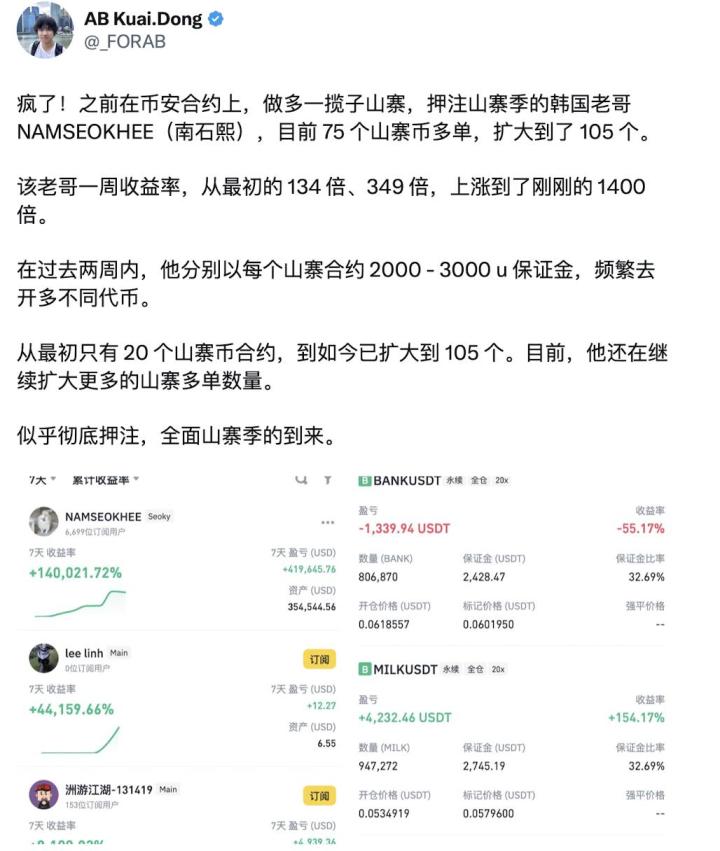Chainfeeds Preface:
In this conversation, co-founders of ABCDE Du Jun, Hash Global founder KK, Generative Ventures partner Will Wang, Water Drop Capital CEO Jademont (Dashan), NGC Ventures Investment Director Henry, and CatcherVC risk partner Loners Liu and other investors jointly focused on the current situation and challenges of the primary market in the crypto industry, discussing VC survival pressure, exchange aesthetic leadership, industry liquidity drought, and extended investment cycles.
Article Source:
https://www.wublock123.com/article/47/43028
Article Author:
Wu Blockchain
Viewpoints:
Will Wang: I will not comment on ABCDE, I will only talk about my perception. Because we are not specifically doing Crypto, we only started Crypto investment a year and a half ago. I understand that the biggest gap is between the investment returns from the ICO era or early Web3 cycles and the current market returns. Additionally, the community's emotional changes towards VC plates and Non-Fungible Token assets have sparked more discussions. Overall, after doing Crypto VC for a year and a half, we found that VCs are facing significant pressures in several aspects. First, extremely long lock-up periods. This lock-up period is much longer than our previous traditional equity investments, such as a three-year lock-up, which is longer than the six-month unlocking after equity listing. Second, although the project's book valuation looks high before listing on exchanges, when considering Token dilution and other factors, investors' actual returns are not high. This does not match the risks we bear. Because the crypto industry lacks a truly legitimate governance framework and has poor liquidity, the actual risks are very high, while the final return multiples are very low. Third, there is an over-supply problem in primary market assets. Just like in the traditional equity market, where the US has 800 unicorns and China has 300 unicorn enterprises, many projects are accumulated, with severe listing bottlenecks. The crypto field is the same, with numerous projects issuing and circulating tokens, but lacking truly effective exit mechanisms.
Content SourceWu Blockchain: The first line is investing in "commercial application infrastructure". This includes stablecoins, payment systems, commercial data chains, global payroll, and other infrastructure. The second line is investing in "Web3 commercial applications". Because we believe that Crypto finance (DeFi, CeFi) has developed to a stage similar to the internet in 1999, with 600 million users, but the next-generation internet infrastructure Web3 might still be between 1990 and 1995 - meaning killer applications have not yet emerged. So when we invest in Web3 commercial applications, we are not blindly following trends, but more systematically finding traditional enterprises that are already excellent in their respective fields, such as head teams in film copyright, performances, music, sports, and content - both domestically and internationally. We talk to them, telling them that Web3 technology, like AI technology, can empower and improve efficiency. Web3 is not about riding the concept wave, but about truly reducing costs and increasing efficiency. At the current stage, infrastructure is already sufficient, and there's no need to focus too much on which underlying chain it is, as transaction speeds are already sufficient for most application scenarios. The key is to help these traditional businesses find a reason "why they should use Web3". For example, I recently chatted with a tourism industry leader in Singapore who initially thought Web2 could do everything, so why use Web3? I used the Bitcoin example: what Bitcoin means to the traditional financial system, Web3 will have the same significance for the future internet business. Unified ledger, transparent settlement, and global circulation efficiency brought by de-trusting are things the traditional system cannot achieve. So, we must help project parties in each industry find Web3's landing point. For instance, some projects originally had B2B business and now want to do B2C. We tell them they can help users create chain addresses imperceptibly, without even initially telling users about wallets, waiting for the right moment to go on-chain, which can be safer, more efficient, and faster in settlements, reducing from one month to seven days. If this doesn't increase costs but increases revenue, enterprises will naturally be willing to adopt Web3. Once they go on-chain, they might bring massive users to a certain chain, and at that point, we guide them to do Token design, truly establishing a Web3 economic body. So, I believe VCs still have great value, but the approach must change. When truly long-term valuable business models and real PMF emerge, then discuss Token economics, rather than issuing tokens for the sake of issuing tokens.
Content Source








